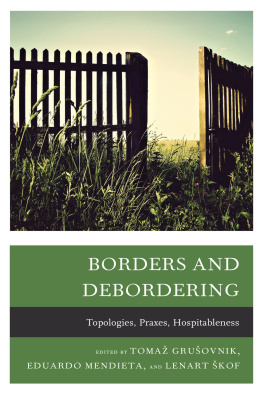Grušovnik Tomaž - Borders and debordering topologies, praxes, hospitableness
Here you can read online Grušovnik Tomaž - Borders and debordering topologies, praxes, hospitableness full text of the book (entire story) in english for free. Download pdf and epub, get meaning, cover and reviews about this ebook. City: Lanham Boulder New York London, year: 2018, publisher: Lexington Books, genre: Romance novel. Description of the work, (preface) as well as reviews are available. Best literature library LitArk.com created for fans of good reading and offers a wide selection of genres:
Romance novel
Science fiction
Adventure
Detective
Science
History
Home and family
Prose
Art
Politics
Computer
Non-fiction
Religion
Business
Children
Humor
Choose a favorite category and find really read worthwhile books. Enjoy immersion in the world of imagination, feel the emotions of the characters or learn something new for yourself, make an fascinating discovery.
- Book:Borders and debordering topologies, praxes, hospitableness
- Author:
- Publisher:Lexington Books
- Genre:
- Year:2018
- City:Lanham Boulder New York London
- Rating:4 / 5
- Favourites:Add to favourites
- Your mark:
- 80
- 1
- 2
- 3
- 4
- 5
Borders and debordering topologies, praxes, hospitableness: summary, description and annotation
We offer to read an annotation, description, summary or preface (depends on what the author of the book "Borders and debordering topologies, praxes, hospitableness" wrote himself). If you haven't found the necessary information about the book — write in the comments, we will try to find it.
Borders and debordering topologies, praxes, hospitableness — read online for free the complete book (whole text) full work
Below is the text of the book, divided by pages. System saving the place of the last page read, allows you to conveniently read the book "Borders and debordering topologies, praxes, hospitableness" online for free, without having to search again every time where you left off. Put a bookmark, and you can go to the page where you finished reading at any time.
Font size:
Interval:
Bookmark:

Borders and Debordering
Borders and Debordering
Topologies, Praxes, Hospitableness
Edited by
Toma Gruovnik, Eduardo Mendieta,
and Lenart kof
LEXINGTON BOOKS
Lanham Boulder New York London
Published by Lexington Books
An imprint of The Rowman & Littlefield Publishing Group, Inc.
4501 Forbes Boulevard, Suite 200, Lanham, Maryland 20706
www.rowman.com
Unit A, Whitacre Mews, 26-34 Stannary Street, London SE11 4AB
Copyright 2018 The Rowman & Littlefield Publishing Group, Inc.
All rights reserved . No part of this book may be reproduced in any form or by any electronic or mechanical means, including information storage and retrieval systems, without written permission from the publisher, except by a reviewer who may quote passages in a review.
British Library Cataloguing in Publication Information Available
Library of Congress Cataloging-in-Publication Data
Names: Mendieta, Eduardo, editor.
Title: Borders and debordering : topologies, praxes, hospitableness / edited by Toma Gruovnik, Eduardo Mendieta, and Lenart kof.
Description: Lanham : Lexington Books, 2018. | Includes bibliographical references and index. | Description based on print version record and CIP data provided by publisher; resource not viewed.
Identifiers: LCCN 2018009104 (print) | LCCN 2018005672 (ebook) | ISBN 9781498571319 (electronic) | ISBN 9781498571302 (cloth : alk. paper)
Subjects: LCSH: Boundaries (Philosophy) | Ontology. | Emigration and immigration. | Hospitality.
Classification: LCC BD392 (print) | LCC BD392 .B67 2018 (ebook) | DDC 110dc23
LC record available at https://lccn.loc.gov/2018009104
 The paper used in this publication meets the minimum requirements of American National Standard for Information SciencesPermanence of Paper for Printed Library Materials, ANSI/NISO Z39.48-1992.
The paper used in this publication meets the minimum requirements of American National Standard for Information SciencesPermanence of Paper for Printed Library Materials, ANSI/NISO Z39.48-1992.
Printed in the United States of America
Contents
Toma Gruovnik, Eduardo Mendieta, and Lenart kof
Edward S. Casey
Mary Watkins
Eduardo Mendieta
Helena Motoh
Victor Forte
Mary Leonard
Reingard Spannring
Toma Gruovnik
Klaus-Gerd Giesen
Petri Berndtson
Lenart kof
Sh Hawke
Toma Gruovnik, Eduardo Mendieta, and Lenart kof
In the waters of the Mediterranean Sea that serves as a border between Europe and Africa, in the hot sands of the deserts of the Middle East, where borders have burned and shifted with the fate of empires and falling nations, and arguably at the US-Mexico border, a border that until very recently was an imaginary line on the beds of drying rivers and inhospitable deserts, we are facing one of the most chilling humanitarian crisis of our recent times: the crisis of migrants and refugees. In a world in which we are witnessing other humanitarian tragedies (i.e., civil wars in many countries, resource and water wars, eco-refugees, i.e., peoples displaced by severe weather, and human trafficking, to name the most glaring contemporary cases), as well as ignorance by a large part of the policy makers about the implications of the massive and tragic migratory flows, it is important to identify those sources in political, ethical, and legal thinking that can help us face these overwhelming tragedies justly, ethically, and humanely. This edited collection is dedicated to the analysis of various concepts of borders as concepts, technologies, praxes, division lines, physical fences and wallsthat divide, denigrate, humiliate, oppress, neglect, disable, expose, and ultimately kill human beings and non-human animals. This collection, however, is also about practices and forms of worlding that could enable borders to become less fateful and lethal, less divisive and intransigent, less disabling of our encounters, and thus, perhaps empower, enable, mediate ethical subjects to deborder various layers of our ethical, social, and political lives. Borders and bordering are contingent facts, events, and practices, which, nonetheless, have, in some cases, normative claims, or claims that point to moral and legal standards and norms. The borders of a city, during the Middle Ages for instance, was the wall that defended it. The border of a nation was a manifestation of national sovereignty, which had to do with the legal and political autonomy of a people. What we may say and how we interact physically with other members of our polity, is also mapped by certain boundaries, boundaries that when violated fall under the aegis of sexual harassment or outright sexual violence. Borders have this Janus face: they are traces of history, but at some point they also have a normative face. By the same token that they are traced, erected, built, policed, monitored, and regulated, they can also be dismantled, toppled, ignored, and ultimately found to be illegitimate, illegal, unethical, and ultimately inhuman. One of the goals of this collection, then, is to unmask and expose borders to their double bind: their contingency and their need to give normative accounts of their existence, if they are to demand our deference, respect and allegiance.
It is for this reason that among the central topics this collection wishes to address are the migration crises as they appear at various bordersconcrete and visible, as well as more subtle and thus at first blush invisiblewhile also aiming to analyze the conceptual logics that command and enable various political subjects to neglect and violate basic humanitarian laws and ethical norms. In this book, then, we wish to explore different ways of conceptualizing the normative links between the migration crises, political conflicts and a more peaceful and hospitable world.
Ours are times of uncertainty, brutal facts, and lucid normative claims, which demand new answers about our increasingly precarious dwelling in the world, about unequally shared insecurities and modalities of risk of our being-in-the-world, and about the political futures we should wish to share. We always face borders in our lives, some of them visible, and some of them concealed, or even latently present in subjectivities and bodies. In this anthology, Borders and Debordering: Topologies, Praxes, Hospitableness , we seek to engage from an interdisciplinary and transnational perspective some of the most important issues of the present, related to physical, epistemological, spiritual, and existential borders. This book addresses a variety of topics and themes connected with the role of the body at the threshold between subjective identities and intersubjective spaces that are drawn in ontology, epistemology, and ethics, as well as with borders as these are inscribed in intersubjective, social, and political spaces (such as gender/sexuality/race, human/animal/nature/technology, etc., divisions).
The first section of the volume, Bordering Topologies, is dedicated to reflections on the nature of borders and boundaries as well as their phenomenological implications for human souls and bodies. In the first chapter, Professor Edward S. Casey writes about border walls that are being erected around the globe to stem the flow of migrants. Based on his previous work on memory, place, and edge, Professor Caseys chapter sees border walls as constituting the critical edges of forced migrational movements. His phenomenological analysis understands mobility as an inherent trait of bodily existence, implying that all borders at some point yield to moving bodies and become boundaries. For Professor Casey, however, the truest opening in those walls would be hospitality . His chapter thus ends with an analysis of Derridean reflections on the aporetic nature of this notion, trying to flesh out hospitality for our troubled times, plagued with inhospitable treatment of an unprecedented number of migrants.
Font size:
Interval:
Bookmark:
Similar books «Borders and debordering topologies, praxes, hospitableness»
Look at similar books to Borders and debordering topologies, praxes, hospitableness. We have selected literature similar in name and meaning in the hope of providing readers with more options to find new, interesting, not yet read works.
Discussion, reviews of the book Borders and debordering topologies, praxes, hospitableness and just readers' own opinions. Leave your comments, write what you think about the work, its meaning or the main characters. Specify what exactly you liked and what you didn't like, and why you think so.











